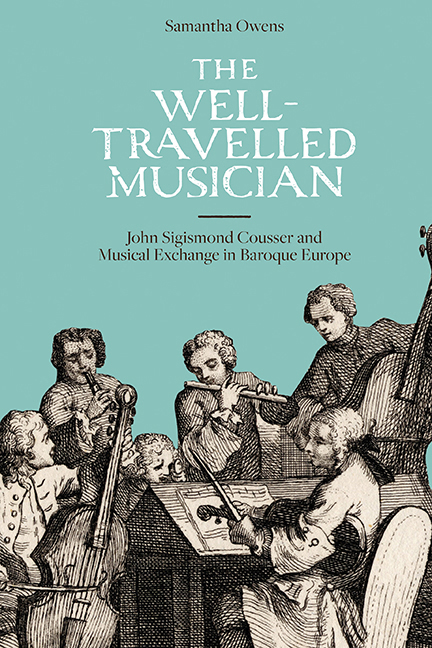Book contents
- Frontmatter
- Dedcation
- Contents
- List of Tables
- Preface
- Abbreviations
- Notes on Sources
- Introduction: John Sigismond Cousser and his ‘Commonplace Book’
- 1 Hungarian Beginnings and the Adoption of French Musical Style
- 2 Kapellmeister at the Wolfenbüttel Court and Braunschweig Opera House
- 3 Ariadne to Porus: Cousser's Braunschweig Operas
- 4 ‘The Incomparable Director’ in Hamburg, Nuremberg and Augsburg
- 5 Heliconische Musen-Lust: Opera at the Württemberg Court
- 6 ‘Il Paradiso terrestre’? Cousser in London
- 7 ‘Fortune not Blind’: Music for Dublin Castle
- 8 ‘Our Concert’: A Musician at Home
- 9 Cousser's ‘collection of fine musick’ and the Practicalities of Musical Exchange
- Appendix 1 Summary of the Contents of Cousser's ‘Commonplace Book’
- Appendix 2 Cousser's Address Book
- Appendix 3 Cousser's Books of Cantatas, Madrigals, Duets and Serenatas
- Appendix 4 Cousser's Inventory of Ouverture Incipits
- Appendix 5 Transcription of Cousser's Notes for his 1716 Trip to London and the Continent
- Bibliography
- Index
- Titles listed here were originally published under the series title Music in Britain, 1600–1900
- New titles published under the series title Music in Britain, 1600–2000
- Frontmatter
- Dedcation
- Contents
- List of Tables
- Preface
- Abbreviations
- Notes on Sources
- Introduction: John Sigismond Cousser and his ‘Commonplace Book’
- 1 Hungarian Beginnings and the Adoption of French Musical Style
- 2 Kapellmeister at the Wolfenbüttel Court and Braunschweig Opera House
- 3 Ariadne to Porus: Cousser's Braunschweig Operas
- 4 ‘The Incomparable Director’ in Hamburg, Nuremberg and Augsburg
- 5 Heliconische Musen-Lust: Opera at the Württemberg Court
- 6 ‘Il Paradiso terrestre’? Cousser in London
- 7 ‘Fortune not Blind’: Music for Dublin Castle
- 8 ‘Our Concert’: A Musician at Home
- 9 Cousser's ‘collection of fine musick’ and the Practicalities of Musical Exchange
- Appendix 1 Summary of the Contents of Cousser's ‘Commonplace Book’
- Appendix 2 Cousser's Address Book
- Appendix 3 Cousser's Books of Cantatas, Madrigals, Duets and Serenatas
- Appendix 4 Cousser's Inventory of Ouverture Incipits
- Appendix 5 Transcription of Cousser's Notes for his 1716 Trip to London and the Continent
- Bibliography
- Index
- Titles listed here were originally published under the series title Music in Britain, 1600–1900
- New titles published under the series title Music in Britain, 1600–2000
Summary
IF my memory serves me correctly, it was at a baroque oboe course held at the Staatliche Hochschule für Musik, Trossingen, in 1998 that Alfredo Bernardini first drew my attention to John Sigismond Cousser's ‘commonplace book’. Clearly this was a fascinating document in its own right, but Alfredo also hinted that Cousser's music was well worth exploring. Somewhat inexplicably, after that Cousser kept resurfacing in the course of my research on other topics, most notably in 2005, when I realised that a set of manuscript orchestral parts for an unknown German-language opera held at the Württembergische Landesbibliothek in Stuttgart was partly written in his hand. This discovery eventually led to the performance of major sections of the work, Adonis, at Karlsruhe's Badisches Staatstheater under the musical direction of Peter Van Heyghen, as part of the Internationale Händel-Akademie 2011.
Since then, many other musicians have also brought Cousser's music to life for me, and I am equally grateful to them for their interest and enthusiasm: Georg Corall and Les Hautboïstes de Prusse (Berlin), Emma Goodbehere, Douglas C. Mews and Rowena Simpson (Wellington), Rüdiger Kurz and Il Gusto Barocco (Stuttgart), and Balázs Máté and Aura Musicale (Budapest). But I am particularly grateful to Peter Whelan and his excellent period band Ensemble Marsyas (Edinburgh), whose performances of Cousser's serenata The Universal Applause of Parnassus at Dublin Castle (2015) and Wigmore Hall (2016) have counted among my musical highlights of the past two years. And, as I type, I am counting down the months until their upcoming performance of Cousser's serenata celebrating the Peace of Utrecht, scheduled for Dublin Castle in August 2017. Every one of these performances has demonstrated to me that Alfredo's judgement of Cousser was not misplaced.
Despite having now published this volume, I am conscious of the fact that much work on Cousser remains to be done. The music listed by him in his so-called ‘commonplace book’ (which I have chosen instead to refer to as his notebook, see Introduction) runs to more than 1,000 items and, ultimately, a full transcription and associated commentary proved to be beyond the scope of this book. Fortunately, this absorbing source is freely available for perusing online (in full colour) on the website of the Beinecke Rare Book and Manuscript Library, Yale University.
- Type
- Chapter
- Information
- The Well-Travelled MusicianJohn Sigismond Cousser and Musical Exchange in Baroque Europe, pp. ix - xiPublisher: Boydell & BrewerPrint publication year: 2017

